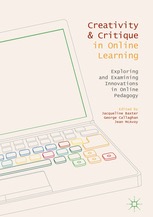online learning
Select an item by clicking its checkbox
"We are all wanderers on this planet.”[1] In my wanderings through the written word over the last month, I met the American poet Robert Lax (1915-2000). For a time his greatest claim to fame was his deep and lasting friendship with the Trappist monk Thomas Merton, yet Lax’s contributions ...
Whether teaching online or face-to-face courses, Mary Hess, Luther Seminary, aims to create spaces where (in the words of Parker Palmer) obedience to truth can be practiced. “Learning,” she argues, “is risk-taking.” But she lets her students know that she, as the teacher, is with them in their learning adventure. Dr. Hess has had a variety of leadership roles at the Wabash Center over many years.
The “I” That Teaches - A new video project that invites senior scholars to talk about their teaching lives. These scholar-teachers candidly discuss how religious, educational, and family backgrounds inform their vocational commitments and, also, characterize their teaching persona. From the vantage point of a practiced teaching philosophy we get an intimate account of the value and art of teaching well.
Click here to watch all episodes of "The "I" That Teaches" on YouTube
See Also:
In theological education, students who go to school online are frequently students who remain at home throughout their degree programs serving in faith communities they know well. This reality affects their formation and affects how teachers approach it. There are some advantages to the situation. As Elaine Ramshaw writes about ...
Course design in online learning juggles a range of factors to produce an effective learning environment. For instance, most of us who teach online must navigate the expectations of our institution. Maybe a requirement to adhere to some external standard, like Quality Matters, exists. Perhaps the learning management system defines ...

Creativity & Critique in Online Learning: Exploring and Examining Innovations in Online Pedagogy
Date Reviewed: December 13, 2018
The growth of online education prompts a need for qualitative research about student learning outcomes and teaching methodologies. It also requires the production of specific educational material that is consonant with this educational medium. In addition, practical advice for online educational methods is warranted. This book is a collection of articles that address a range of concerns within online education. The authors do a good job in the critical assessment of the current possibilities that online education provides. It also invites readers to engage in complex discussions about online education in the future.
Creativity and Critique in Online Learning is divided into two parts. The first part is concerned with teaching practices. In particular, it examines available online teaching instruments and places online education in a broader context. This section of the book contributes a detailed analysis of online forums, discusses ways to make online teams work effectively, and explores how popular social networks, such as Facebook, contribute to informal learning. It also discusses what role multisensory learning has in online space, how to use all the senses in online education, as well as how to nurture creativity and critical assessment. This section is of interest to teachers and students alike because it looks at practical aspects of online education and gives useful advice on how to use them productively.
The second part of the book focuses on particular online teaching challenges and how to effectively engage them. Online academic cheating, its growth, and various ways to fight this phenomenon are addressed. In addition, it provides help for how to build successful relationships, instill values, and cherish identity in the online teaching community. This section also takes a closer look at massive open online courses and their drawbacks, both explicit and implicit. One of the most interesting articles in this part is “The Move to Online Teaching: A Head of Department’s Perspective” by Diane Preston. This chapter invites readers to examine online education through the eyes of an experienced educator who is concerned about both the teaching process and institutional concerns.
Overall, Creativity and Critique in Online Learning is recommended for a broad audience of educators. It contains useful information for teachers who are currently involved in online teaching, scholars, and policymakers in online education, as well as teachers practicing a traditional form of education and looking for interesting and innovative ways to make their subjects more appealing to contemporary students. One of the main pros of this book is that it does not try to present online education as a modern teaching panacea or the only choice for education in the future. On the contrary, the book presents online teaching in an unbiased manner. While it certainly praises the advantages and possibilities online education has for all participants of the teaching process, it also reveals existing flaws and addresses specific dangers of online education.


